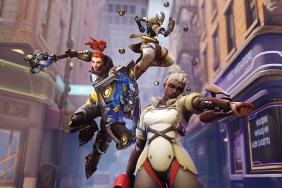Warning: More Talky Than Metal Gear, But Way Funnier!
If I had to make a generalization about the Danganronpa series, it would be that the gameplay is almost incidental to the twisty plot and character interactions. The original Danganronpa in particular used a lot of standard animé and manga tropes with its characters to subvert player expectations and completely turn them on their head throughout the narrative. The investigation-style narrative, with an almost Ace Attorney-styled gameplay and plot advancement that allowed for this to play out with near constant twists and turns, first for its high school cast and then for their whole world as they discover that a giant catastrophe has destroyed it.
So comparatively, Danganronpa Another Episode: Ultra Despair Girls is an odd entry in the series. I mean, it's a third-person shooter from a development team that makes adventure/visual novel titles. In the game you play as Komaru Naegi, the sister of the protagonist of the original game, Mokoto Naegi. While the tragic events that are destroying the world are going on, Komaru has been locked up, Oldboy-style, until a monokuma (a devilish robotic bear fans of the series will be familiar with) breaks down her door and attempts to kill her. Escaping the apartment, she is saved by Byakuya Togami (the obnoxious rich prodigy from the first game) who hands her a bullhorn "hacking gun" that fires orbs that can reprogram the monokuma robots and other devices with electronic signals (though mostly you use it to make them self-destruct).
On her way towards escaping, she is captured by a group of children controlling the robots, calling themselves The Warriors of Hope, who want to wipe out all adults in the city, making it a paradise for children. Letting her go so they can hunt her for sport, The Warriors of Hope leave Komaru who is then saved from another wave of robots by Toko Fukawa, another character from the first game—whose split personality is the serial killer Genocide Jack, with both personalities in love with Byakuya—who agrees to help Komaru in order to get closer to (you guessed it) Byakuya. The player can switch to using Genocide Jack in the middle of play, for a limited time, who destroys the robots in a berserker frenzy.
Danganronpa Another Episode: Ultra Despair Girls feels like less of a game and more of an empty vessel in which to tell this particular part of the larger Danganronpa story (set between games 1 and 2). The gameplay is passable as a shooter, but not particularly engaging, and the environmental exploration isn't particularly visually interesting or exciting. The shooting mechanic isn't particularly accurate or easy to use with any great precision, and I often found myself having to awkwardly run from robots I would have easily destroyed in any other shooter.
However, it's clear that this isn't the point: Ultra Despair Girls is a visual novel that has third-person shooter elements, not a third-person shooter itself with a super-involved plot… but that's the biggest problem. Too much time is taken up with the shooting and exploration elements in what would have been better as a walking simulator or straight-up visual novel. The story is gloriously bizarre, with the same nutty sense of humor (you save your progress by sitting on an oversized potty-training toilet), but it could have used a different gameplay experienced to be wrapped around.
Back at GDC earlier this year, I got to talk to Kazutaka Kodaka, the series' writer. In some ways, Mr Kodaka made it almost sound like the course of the game's design had been decided on a whim. He mentioned the difficulty in having to craft individual stories for all the characters in a regular Danganronpa game and wanting to make a more straightforward story. However, he also said the third-person shooter game couldn't be too difficult, since the game's fanbase in Japan is mostly female visual novel fans who aren't interested in that kind of game: Toko/Genocide Jack was introduced essentially as a no-fail mode option for those players.
While this allows for an interesting look at a cross section of Japanese gaming culture, and its creators' views on gender and gaming demographics (with which there may be a problematic relationship for more progressive Western gamers), it doesn't necessarily make for the best game. Danganronpa Another Episode: Ultra Despair Girls is fantastic if your interest is learning what happened to some of the characters between Danganronpa 1 and 2, but as a third-person shooter it's only generally passable but not particularly engaging. Though fans of the series will find a lot to love in the story, it has a particular niche appeal (and I really adored it), but as a complete gameplay experience, it isn't for everyone.
-
Engaging zany story, characters.
-
Lackluster 3rd person shooting.
-
Best looking game in the series.
-
Again, the story is ridiculous in the best way.
-
Too much time spent outside the story.












